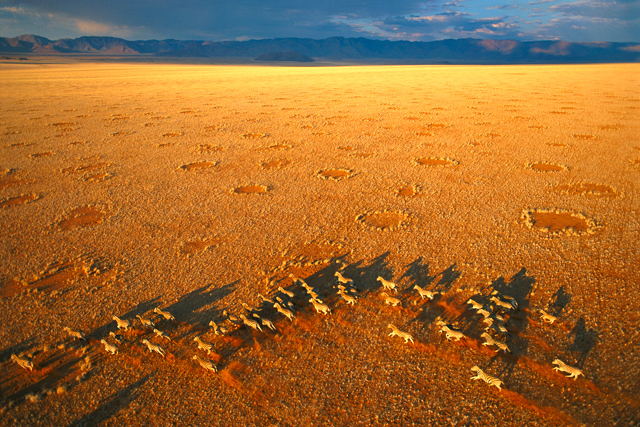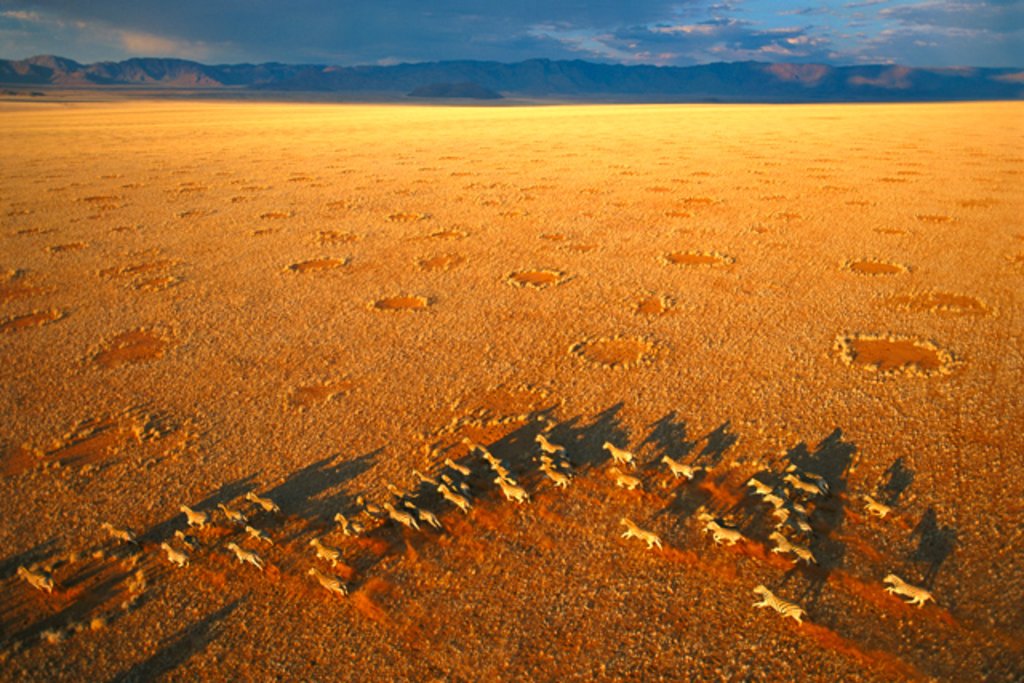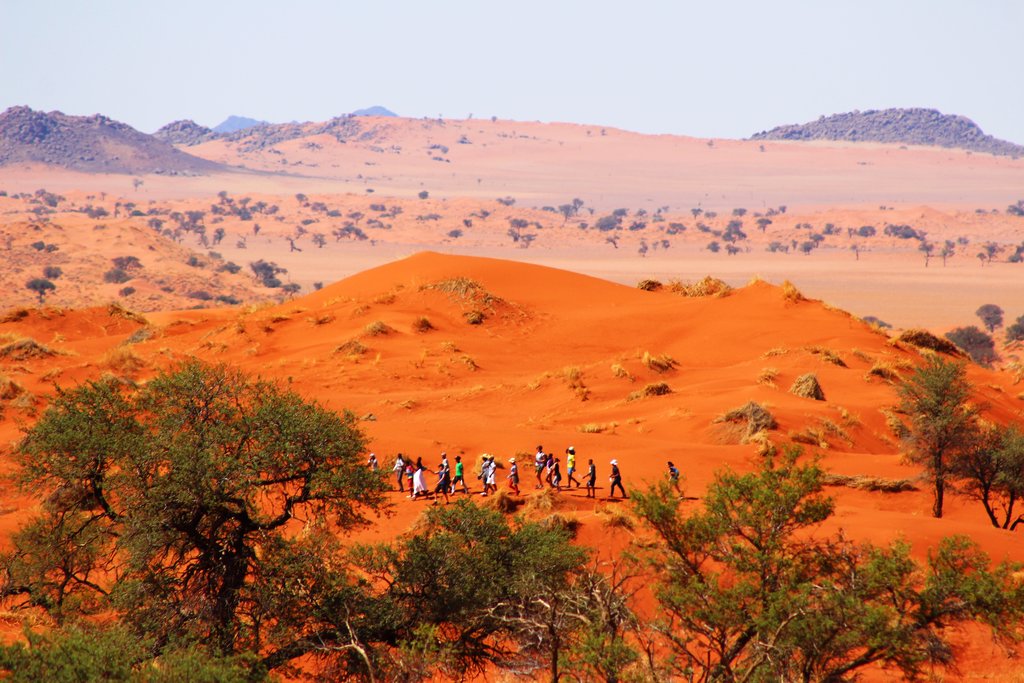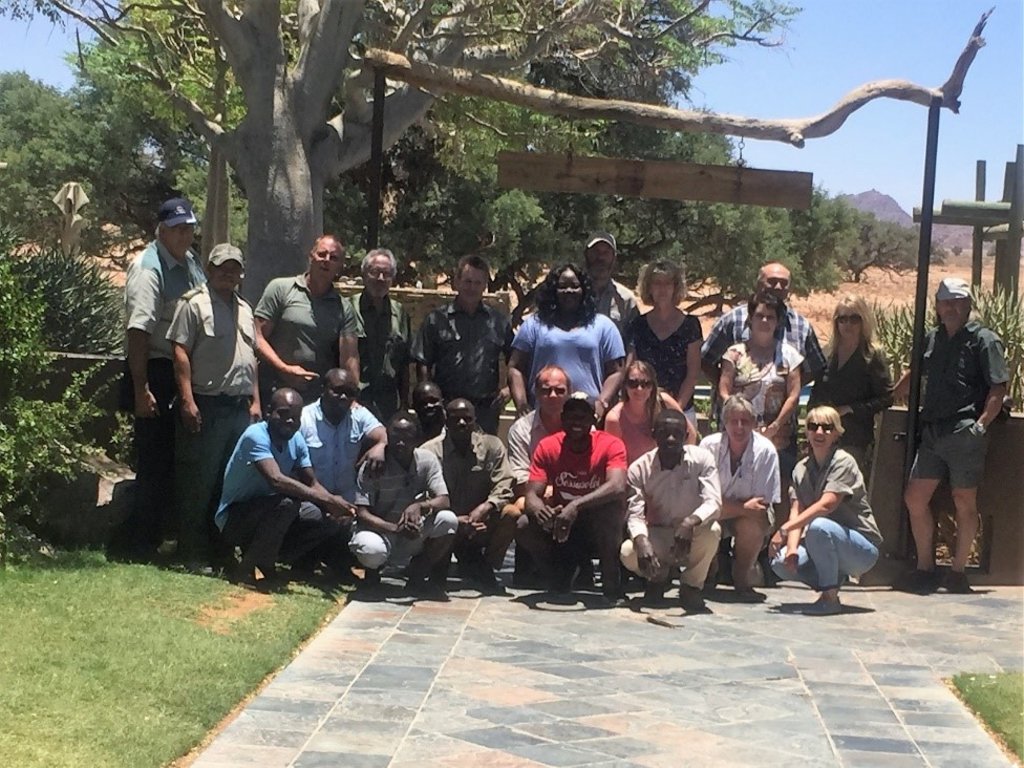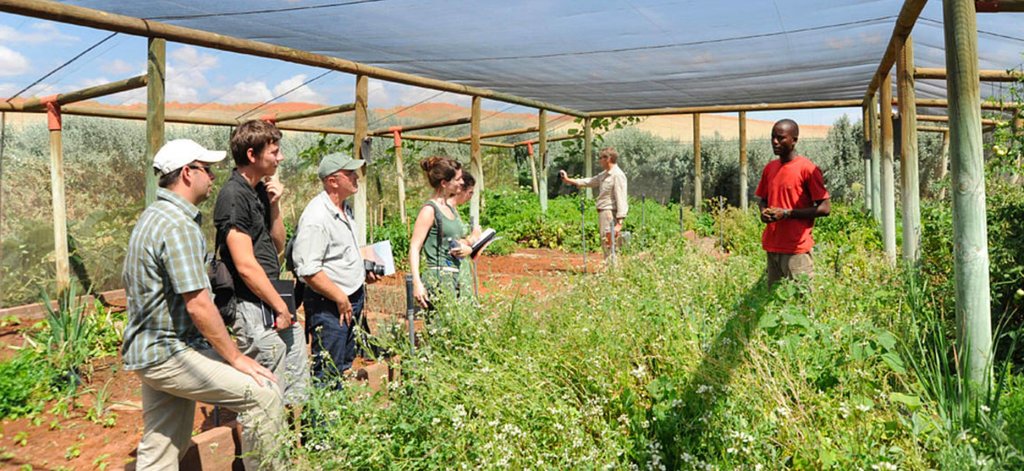Restoration of game migration routes across the Namib Desert [ناميبيا]
- تاريخ الإنشاء:
- تحديث:
- جامع المعلومات: Ibo Zimmermann
- المحرر: –
- المراجعون: Rima Mekdaschi Studer, Simone Verzandvoort, Donia Mühlematter
NamibRand Nature Reserve
approaches_3286 - ناميبيا
- Restoration of game migration routes across the Namib Desert: 2 نوفمبر، 2021 (public)
- Restoration of game migration routes across the Namib Desert: 6 أكتوبر، 2018 (inactive)
- Restoration of game migration routes across the Namib Desert : 13 إبريل، 2018 (inactive)
- Restoration of game migration routes across the Namib Desert : 23 فبراير، 2018 (inactive)
- Restoration of game migrations across Namib Desert: 12 يناير، 2018 (inactive)
عرض الأقسام
توسيع الكل طي الكل1. معلومات عامة
1.2 تفاصيل الاتصال بالأشخاص الرئيسيين لمصدر المعلومات والمؤسسات المعنية بتقييم وتوثيق النهج
اسم المشروع الذي سهّل توثيق/تقييم النهج (إذا كان ذلك على صلة)
NamibRand Nature Reserveاسم المؤسسة (المؤسسات) التي سهلت توثيق/تقييم النهج (إذا كان ذلك على صلة)
Namibia University of Science and Technology ( NUST) - ناميبيا1.3 الشروط المتعلقة باستخدام البيانات الموثقة من خلال WOCAT
متى تم تجميع البيانات (ميدانيا)؟:
01/11/2017
يوافق جامع المعلومات والشخص (لاشخاص) الرئيسي لمصدر المعلومات على الشروط المتعلقة باستخدام البيانات الموثقة من خلال WOCAT:
نعم
2. وصف نهج الإدارة المستدامة للأراضي
2.1 وصف موجز للنهج
Seventeen former sheep farms have been joined to form the world’s largest private nature reserve aimed at regenerating biodiversity to support high-quality low-impact tourism, environmental education and research. All farm owners are members of the management association.
2.2 وصف تفصيلي للنهج
وصف تفصيلي للنهج:
The NamibRand Nature Reserve is a not-for-profit organisation in south-western Namibia. It was founded in 1984 through the initiative of one farm owner, Albi Brueckner, who agreed, with 16 neighbouring farmers, to jointly manage their 215,000 ha for nature conservation and tourism. Its aims are:
To conserve biodiversity for the benefit of future generations and protect the sensitive and fragile environment.
To create a nature reserve with a healthy and functioning ecosystem, providing a sanctuary for flora and fauna, and to facilitate seasonal migratory routes in partnership with neighbours.
To promote sustainable utilisation – through ecologically sustainable and high-quality tourism and other projects.
To achieve a commercially viable operation to ensure continuity and financial independence.
The NamibRand Nature Reserve’s contributions to biodiversity conservation, in accordance with the environmental management plan, include the following:
• Removal of over 2,000 km of fencing to reinstate wildlife migration routes.
• Re-introduction of giraffe and cheetah.
• Bolstering numbers of red hartebeest and plains zebra.
• Removal of alien invasive vegetation such as Prosopis species and replacing these with indigenous Acacias.
• Zonation according to land use areas, including the setting aside 15% of the reserve as a wilderness area.
• Limiting overnight visitors to an average of one bed per 1,000 ha, and 25 beds per location.
• Conducting annual game counts, with results posted on the website www.namibrand.org
• Monitoring the endemic Hartmann’s mountain zebra through the use of camera traps. Results are at: http://www.nnf.org.na/project/mountain-zebra-project/13/1/12.html
• Continuous monitoring of drivers and determinants of environmental change to guide the management plan. Results are posted online at: http://www.landscapesnamibia.org/sossusvlei-namib/rainfall-monitoring
• Hosting researchers to study game migration routes. Results of wildlife monitoring, through the use of GPS collars are at: http://www.landscapesnamibia.org/sossusvlei-namib/research
• Hosting the Namib Desert Environmental Education Trust (NaDEET), to empower and educate schoolchildren for a sustainable future. It operates an environmental education and sustainable living centre (www.nadeet.org).
• A lighting management plan to qualify as an international dark sky reserve that avoids negative consequences of light pollution on biodiversity – which can interfere with animal navigation, reduce the hunting success of predators and prevent moths from pollinating (http://www.darksky.org/idsp/reserves/namibrand)
• A water management plan, including monitoring of the impact of a water hole on the surrounding vegetation.
• Implementation of tourism and land use zonation plans.
• Capture and sale of live game for wildlife population management purposes.
• Plans to develop a horticultural project to grow indigenous medicinal plants for commercial production, creating local jobs and income for conservation.
Rangeland management is achieved largely through continual monitoring and control of animal populations, and the balance between functional groups of their species, and turning off the water supply where grasses are in need of rest. Local outreach efforts focus mainly on predator-livestock management on neighbouring farms.
Stakeholders comprise the land owners, who agree on joint management, and the tourism concessionaires who operate in the reserve under contract. The reserve employs 12 people who are responsible for day-to-day management and maintenance. Biodiversity and land management are funded from park fees collected by the concessionaires from tourists who stay at their establishments. This small management team is possible, because tourism concessionaires offer scenic game drives across the reserve, while on the lookout for required action. For example, guides report issues such as leaking water pipes, unusual wildlife sightings, injured animals, and trespassers (etc.) to reserve managers, who can then react.
Land owners who have connected their land to the reserve and are members of the NamibRand Nature Reserve Association have the option of serving as directors of the association, with joint decision making powers. Those who choose not can still contribute to the strategic mission of the reserve at annual general meetings.
2.3 صور عن النهج
2.4 فيديوهات عن النهج
تعليقات، وصف موجز:
Short introduction to the reserve
https://www.youtube.com/watch?v=QVQgJlBXn78
التاريخ:
01/04/2015
الموقع:
NamibRand Nature Reserve
اسم مصور الفيديو:
IUCN-PAPACO
تعليقات، وصف موجز:
View of landscapes in the reserve
https://www.youtube.com/watch?v=8LZI2ZtPhbg
التاريخ:
15/09/2014
الموقع:
NamibRand Nature Reserve
اسم مصور الفيديو:
Christine Guillot, Etendues Sauvages
تعليقات، وصف موجز:
Organic garden at lodge in the reserve
https://www.youtube.com/watch?v=U7RVKfeQ-0M
التاريخ:
05/04/2016
الموقع:
NamibRand nature Reserve
اسم مصور الفيديو:
Ticket2Utopia – Dr. Paul Goddard
2.5 البلد/المنطقة/المواقع التي تم تطبيق النهج فيها
البلد:
ناميبيا
المنطقة/الولاية/المحافظة:
Southwestern Namibia in the Namib Desert.
Map
×2.6 تواريخ بدء وإنهاء تنفيذ النهج
أشر إلى سنة البدء:
1984
في حالة عدم معرفة السنة بالتحديد، يرجى الإشارة إلى التاريخ التقريبي لبدء النهج:
منذ 10-50 سنة
التعليقات:
The first property was purchased in 1984. The reserve was registered as a Game Reserve in 1992 and registered as the NamibRand Nature Reserve, an Association Not for Gain, in 2002
2.7 نوع النهج
- مبادرة محلية حديثة/مبتكرة
2.8 الغايات/الأهداف الرئيسية للنهج
The approach aims, through participatory land use planning, to restore ecosystem function in the reserve and its surroundings to support high-quality, low-impact tourism that provides the means to support environmental education and other conservation projects.
The overall Strategic Vision of the NamibRand Nature Reserve is to manage the Pro-Namib area, alongside the Namib Desert, for the enhanced conservation of the landscape and its biodiversity.
2.9 الظروف التي تمكن أو تعيق تنفيذ التقنية/التقنيات المطبقة بموجب النهج
المعايير والقيم الاجتماعية /الثقافية/ الدينية
- تمكين/تمكيني
The area was historically visited by migrant San people and more recently by Nama people, who have settled permanently elsewhere. Since no people were living permanently in this hyper-arid ecosystem, the use of the area exclusively for nature conservation remains uncontested.
توفر/الوصول إلى الموارد والخدمات المالية
- تمكين/تمكيني
The establishment of the reserve was initially possible through the ample financial resources of wealthy, altruistic and philanthropic investors.
- معيق
The properties that make up the NamibRand Nature Reserve are located in a hyper-arid ecosystem. Farmers who attempted livestock farming there in the past almost all failed to establish economically viable farms, and most of them overextended themselves financially, resulting in the foreclosure of their farms. For this reason, the area became known as the “Bankruptcy Belt”. Banks were, in the past, extremely reluctant to extend loans to landowners in this area, due to the low value and low agricultural potential. In recent years, the successes of conservation and tourism have changed this situation and banks are now prepared to accept farms with such land use as collateral for extending loans.
الإطار المؤسساتي
- تمكين/تمكيني
Progressive government company laws, such as the possibilit y to register a Section 21 company (“Association Not for Gain”) allow financial resources to be re-invested in conservation so as to further the objectives of the non-profit association. Section 21 companies also do not have to pay company taxes to the government.
التعاون/التنسيق بين الجهات الفاعلة
- تمكين/تمكيني
Articles of Association and the management plan allow for the creation of a management team that effectively coordinates all activities on the reserve.
الإطار القانوني (حيازة الأراضي، وحقوق استخدام الأراضي والمياه)
- تمكين/تمكيني
Rights and therefore the possibility to benefit from wildlife are enshrined in the Nature Conservation Ordinance of 1975.
- معيق
The current Nature Conservation Ordinance of 1975 does not allow for the registration of private nature reserves. The status of the land with the government thus remains as agricultural land, and law enforcement has to rely on common law such as trespassing on private property.
السياسات
- تمكين/تمكيني
Progressive, enabling policies of the Ministry of Environment and Tourism, such as the tourism policy and the parks and neighbours policy ensure meaningful collaborations between the public and the private sector. See http://www.met.gov.na
حوكمة الأراضي (صنع القرار والتنفيذ والإنفاذ)
- تمكين/تمكيني
Good governance is achieved through the adoption of Articles of Association and management plans. These guide decision-making and enable implementation. A set of rules, called the Vade Mecum, enable enforcement.
المعرفة حول الإدارة المستدامة للأراضي، والوصول إلى الدعم الفني
- تمكين/تمكيني
Good networking, membership to various professional bodies and collaboration with universities and researchers ensure good knowledge about sustainable land management and technical support.
الأسواق (لشراء المدخلات وبيع المنتجات) والأسعار
- تمكين/تمكيني
A well-established tourism market to Namibia ensures a steady stream of visitors to the NamibRand Nature Reserve, enabling the collection of park fees and thus ensuring income for the reserve.
- معيق
The remoteness of the reserve, 150km from the nearest town, results in expensive transport charges for goods and inflated prices for professional services.
عبء العمل، توفر القوى العاملة
- تمكين/تمكيني
Guides from tourism concessions on the reserve allow for sharing of workloads. Availability of human resources in the region is ample.
3. المشاركة وأدوار الأطراف المعنية
3.1 أصحاب المصلحة المعنيون بالنهج وأدوارهم
- مستخدمو الأراضي المحليون/المجتمعات المحلية
17 former livestock farms owned by 12 companies, now converted to tourism enterprises
Some of them serve as directors of the NamibRand Nature Reserve Association, for joint decision making
- متخصصون في الإدارة المستدامة للأراضي / مستشارون زراعيون
12 reserve management staff
To manage the reserve
- الباحثون
Visiting researchers from various academic institutions
To conduct research to help with applied research for management and "interest research" such as on “fairy circles”, which can be seen in the cover photo. The origin of these circles of bare soil surrounded by grass is still being disputed among scientists (https://www.youtube.com/watch?v=2VNyo9AoA8I). There is a Wildlife monitoring programme partnership with Namibia University of Science and Technology and the Greater Sossusvlei Landscape Association
- المعلمون / أطفال المدارس / الطلاب
4 full-time teachers at NADEET and 10 instructors at hospitality training centre.
To expose about 1000 visiting students per year to environmental education and to provide vocational training to about 100 trainees per year.
- منظمة غير حكومية
Cheetah Conservation Fund and Giraffe Conservation Fund.
To reintroduce predators and wild herbivore species.
- القطاع الخاص
Neighbouring farms
Co-management of the larger landscape with like-minded neighbours, as indicated at: http://www.landscapesnamibia.org/sossusvlei-namib/
- الحكومة الوطنية (المخططون، صانعو القرار)
Ministry of Environment and Tourism.
To assist with law enforcement and wildlife monitoring.
- منظمة دولية
Member of IUCN
For advocacy and knowledge sharing.
3.2 انخراط مستخدمي الأراضي المحليين/المجتمعات المحلية في المراحل المختلفة للنهج
| انخراط مستخدمي الأراضي المحليين/المجتمعات المحلية | حدد من شارك وصف الأنشطة | |
|---|---|---|
| المبادرة/التحفيز | التعبئة الذاتية | The founding farm owner approached philanthropic donors to buy neighbouring farms and invest in tourism facilities and environmental education centre. |
| التخطيط | الدعم الخارجي | In 1991, external experts provided advice for planning of the reserve. Influential persons involved included Chris Brown, Hugh Berry and Haino Rumpf of the Ministry of Environment, and Mary Seely of the Desert Research Foundation. |
| التنفيذ | التعبئة الذاتية | Management staff were appointed in 1991, and paid for from the conservation levy raised from use of tourism facilities in the reserve. |
| الرصد/التقييم | التعبئة الذاتية | Reserve management staff do the monitoring, paid for by the conservation levy. |
| research | الدعم الخارجي | Research institutions conduct research after paying a small service fee. |
3.4 اتخاذ القرار بشأن اختيار تقنية/تقنيات الإدارة المستدامة للأراضي
حدد من الذي قرر اختيار التقنية/التقنيات التي سيتم تنفيذها:
- مستخدمو الأراضي بشكل أساسي، بدعم من متخصصي الإدارة المستدامة للأراضي
اشرح:
The Reserve's vision and mission were set up by its directors, who comprise farm owners willing to serve in this decision making role, at the Initiation workshop in 1991. Management actions were then Implemented under the guidance of various specialists.
حدد على أي أساس تم اتخاذ القرارات:
- تقييم المعرفة الموثقة جيدًا بشأن الإدارة المستدامة للأراضي(اتخاذ القرارات القائمة على الأدلة)
- نتائج البحوث
- خبرة وآراء شخصية(غير موثقة)
4. الدعم الفني وبناء القدرات وإدارة المعرفة
4.1 بناء القدرات/التدريب
هل تم تقديم التدريب لمستخدمي الأراضي / الأطراف المعنيين الآخرين؟:
نعم
حدد من تم تدريبه:
- مستخدمو الأراضي
- موظفون ميدانيون/ مستشارون
- Tourism concessionaires
شكل التدريب:
- في العمل
- مناطق العرض
- اجتماعات عامة
شكل التدريب:
- Exchange visits
المواضيع المغطاة:
Biodiversity conservation, financial management, tourism best practices, principles of co-management, human-wildlife conflict resolution, rehabilitation.
4.2 خدمة استشارية
هل يملك مستخدمو الأراضي وصولا إلى خدمة استشارية؟:
نعم
حدد ما إذا كانت الخدمة الاستشارية متوفرة:
- في حقول مستخدمي الأراضي
- في مراكز دائمة
وصف/تعليقات:
Advice is provided by the Namibia Chamber of Environment, the Namibia Nature Foundation, the Ministry of Environment and Tourism Resource Centre, the Namibia University of Science and Technology, the Giraffe Conservation Fund and other wildlife biologists on issues such as determination of wildlife carrying capacities.
4.3 تعزيز المؤسسات (التطوير التنظيمي)
هل تم إنشاء أو تعزيز مؤسسات من خلال هذا النهج؟:
- نعم، إلى حد كبير
حدد المستوى (المستويات) التي تم فيها تعزيز أو إنشاء المؤسسات:
- محلي
صف المؤسسة والأدوار والمسؤوليات والأعضاء وما إلى ذلك.
NamibRand Nature Reserve Association. All land owners are members, who elect the directors. They manage the reserve according to an agreed strategy.
حدد نوع الدعم:
- مالي
اعط مزيدا من التفاصيل:
Hiring of lawyers and auditors/accountants to establish the association.
4.4 الرصد والتقييم
هل يشكل الرصد والتقييم جزءا من النهج؟:
نعم
التعليقات:
Impacts are monitored to feed back into management.
إذا كانت الإجابة بنعم، فهل من المقصود استخدام هذه الوثائق للمراقبة والتقييم؟:
كلا
4.5 البحوث
هل كانت البحوث جزءًا من النهج؟:
نعم
حدد المواضيع:
- علم الايكولوجيا
أعط تفاصيل إضافية وأشر إلى من قام بالبحوث:
Determination of wildlife carrying capacities by wildlife biologists.
5. التمويل والدعم المادي الخارجي
5.1 الميزانية السنوية لمكون الإدارة المستدامة للأراضي في النهج المذكور
إذا لم تكن الميزانية السنوية الدقيقة معروفة، قم بالإشارة إلى نطاقها:
- 1,000000-100،000
التعليقات (على سبيل المثال المصادر الرئيسية للتمويل/الجهات المانحة الرئيسية):
Self funded from conservation levy collected from tourism income.
5.2 الدعم المالي/المادي المقدم لمستخدمي الأراضي
هل حصل مستخدمو الأراضي على دعم مالي/ مادي لتنفيذ التقنية/ التقنيات؟:
كلا
5.4 الائتمان
هل تم توفير ائتمان في إطار نهج أنشطة الإدارة المستدامة للأراضي؟:
كلا
5.5 حوافز أو وسائل أخرى
هل تم استخدام حوافز أو أدوات أخرى لتشجيع تنفيذ تقنيات الإدارة المستدامة للأراضي؟:
كلا
6. تحليل الأثر والتصريحات الختامية
6.1 آثار النهج
هل ساهم النهج في تمكين مستخدمي الأراضي المحليين وتحسين مشاركة الأطراف المعنية؟:
- لا
- نعم، قليلا
- نعم، باعتدال
- نعم، إلى حد كبير
Interest in owning land has greatly increased. Land prices have risen and more tourism establishments were built.
هل مكّن النهج من اتخاذ القرارات المبنية على الأدلة؟:
- لا
- نعم، قليلا
- نعم، باعتدال
- نعم، إلى حد كبير
Through monitoring, to determine wildlife carrying capacity.
هل ساعد النهج مستخدمي الأراضي على تنفيذ وصيانة تقنيات الإدارة المستدامة للأراضي؟:
- لا
- نعم، قليلا
- نعم، باعتدال
- نعم، إلى حد كبير
Research and expert advice drives appropriate management for the ecology. There are no more sheep and associated weeds, while wildlife numbers increased.
هل نجح النهج في تحسين التنسيق والتنفيذ الفعال من حيث التكلفة لأنشطة الإدارة المستدامة للأراضي؟:
- لا
- نعم، قليلا
- نعم، باعتدال
- نعم، إلى حد كبير
By applying economies of scale. Managed holistically by a small, effective team.
هل نجح النهج في تعبئة/تحسين الوصول إلى الموارد المالية لتنفيذ الإدارة المستدامة للأراضي؟:
- لا
- نعم، قليلا
- نعم، باعتدال
- نعم، إلى حد كبير
Through awarding of tourism concessions and collection of park fees.
هل أدى النهج إلى تحسين معرفة وقدرات مستخدمي الأراضي على تنفيذ الإدارة المستدامة للأراضي؟:
- لا
- نعم، قليلا
- نعم، باعتدال
- نعم، إلى حد كبير
Through various training and research activities.
هل أدى النهج إلى تحسين معرفة وقدرات الأطراف المعنية الأخرى؟:
- لا
- نعم، قليلا
- نعم، باعتدال
- نعم، إلى حد كبير
Through accessing information and gaining knowledge from research.
هل ساهم النهج في بناء/تعزيز المؤسسات والتعاون بين الأطراف المعنية؟:
- لا
- نعم، قليلا
- نعم، باعتدال
- نعم، إلى حد كبير
Through establishment of the association, appointment of the management team and information sharing.
هل ساهم النهج في التخفيف من حدة الصراعات؟:
- لا
- نعم، قليلا
- نعم، باعتدال
- نعم، إلى حد كبير
Through implantation of a joint management plan and shared vision.
هل ساهم النهج في تمكين الفئات المحرومة اجتماعيا واقتصاديا؟:
- لا
- نعم، قليلا
- نعم، باعتدال
- نعم، إلى حد كبير
There are no local communities living within the area, but children from all over the country visit the environmental education centre.
هل أدى النهج إلى تحسين المساواة بين الجنسين وتمكين النساء والفتيات؟:
- لا
- نعم، قليلا
- نعم، باعتدال
- نعم، إلى حد كبير
Through policies prohibiting gender discrimination, implemented by tourism enterprises.
هل شجع النهج الشباب/الجيل القادم من مستخدمي الأراضي على الانخراط في الإدارة المستدامة للأراضي؟:
- لا
- نعم، قليلا
- نعم، باعتدال
- نعم، إلى حد كبير
Through the environmental education and vocational training centres.
هل أدى النهج إلى تحسن في مسائل حيازة الأراضي / حقوق المستخدمين التي أعاقت تنفيذ تقنيات الإدارة المستدامة للأراضي؟:
- لا
- نعم، قليلا
- نعم، باعتدال
- نعم، إلى حد كبير
Through establishment of the Association for joint management and guidelines that are followed in the management plan.
هل أدى هذا النهج إلى تحسين الأمن الغذائي / تحسين التغذية؟:
- لا
- نعم، قليلا
- نعم، باعتدال
- نعم، إلى حد كبير
Through the organic garden of 1 ha irrigated with borehole water and featuring in one of the Youtube videos, the improved financial status of the area and access to meat of culled animals for reserve workers and tourists.
هل أدى النهج إلى تحسين الوصول إلى الأسواق؟:
- لا
- نعم، قليلا
- نعم، باعتدال
- نعم، إلى حد كبير
Due to serving tourism needs.
هل أدى النهج إلى تحسين الوصول إلى المياه والصرف الصحي؟:
- لا
- نعم، قليلا
- نعم، باعتدال
- نعم، إلى حد كبير
Workers have access to borehole water pumped for tourism.
هل أدى النهج إلى استخدام طاقة/ مصادر طاقة أكثر استدامة؟:
- لا
- نعم، قليلا
- نعم، باعتدال
- نعم، إلى حد كبير
Solar power is used to generate electricity and heat water.
هل أدى النهج إلى تحسين قدرة مستخدمي الأراضي على التكيف مع التغيرات المناخية/الظواهر المناخية المتطرفة والتخفيف من الكوارث المرتبطة بالمناخ؟:
- لا
- نعم، قليلا
- نعم، باعتدال
- نعم، إلى حد كبير
Based on naturally adapted species that are able to migrate.
هل أدى النهج إلى توفير فرص عمل ودخل؟:
- لا
- نعم، قليلا
- نعم، باعتدال
- نعم، إلى حد كبير
The current land use based on tourism supports times more employees per unit area compared with former sheep farming.
National economy:
- لا
- نعم، قليلا
- نعم، باعتدال
- نعم، إلى حد كبير
Contribution to national income through higher wages in the tourism industry.
6.2 المحفز الرئيسي لقيام مستخدمي الأراضي بتنفيذ الإدارة المستدامة للأراضي
- زيادة الربح (القدرة)، وتحسين نسبة التكلفة إلى العائد
Through tourism, compared with former sheep farming.
- الحد من تدهور الأراضي
Reliance on more appropriate land use.
- الحد من مخاطر الكوارث
Nature takes better care of itself and is more resilient to drought than sheep farming was.
- انخفاض عبء العمل
Sheep herders are no longer needed and there is a small, efficient management team, assisted by information provided through tour guides when their attention is required.
- الوجاهة والضغط الاجتماعي/التماسك الاجتماعي
Through membership of the association.
- الوعي البيئي
Forms the vision of the association.
- تعزيز المعرفة والمهارات في مجال الإدارة المستدامة للأراضي
Improved resource management due to expert knowledge.
- تحسينات جماليية
There are rules to prevent unsightly buildings and maintain the clear night sky, free from light pollution.
- التخفيف من حدة الصراع
Through the association constitution and discussions at planning meetings working towards the common goal
- Philantropic
Wanting to do good and contribute to conservation.
6.3 استدامة أنشطة النهج
هل يمكن لمستخدمي الأراضي المحافظة على استدامة ما تم تنفيذه من خلال النهج (بدون دعم خارجي)؟:
- نعم
إذا كانت الإجابة بنعم، صف كيف:
Through income largely derived from tourism and partly from sale of captured game animals in accordance with the environmental management plan.
6.4 نقاط قوة/مزايا النهج
| نقاط القوة/ المزايا/ الفرص من وجهة نظر مستخدمي الأراضي |
|---|
| The reserve is centrally and holistically managed by a team. |
| Resilience attained by the large unfenced ecosystem. |
| Land users coming together to sign and form a legally recognised body that is more robust. |
| Tourism is more profitable and sustainable than agriculture for such a hyper arid region. |
| نقاط القوة/ المزايا/ الفرص من وجهة نظر جامع المعلومات أو غيره من الاشخاص الرئيسيين لمصدر المعلومات |
|---|
| Resilience to climate change through natural resources, using the competitive advantage of nature. |
| Private property excludes communal demands and allows fast and easy decision making on land use. |
6.5 نقاط الضعف/ العيوب في المنهج وطرق التغلب عليها
| نقاط الضعف/ المساوىء/ المخاطر من وجهة نظر مستخدم الأراضي | كيف يمكن التغلب عليها؟ |
|---|---|
| There is currently no legislative support from government for protection of private land. | The new wildlife bill being drafted makes provision for privately protected areas. |
| In the eyes of the Ministry of Lands, there are only two types of land, either urban and gazetted (e.g. parks) or agricultural (subject to land tax). | Include a third category of land for protected areas, such as the desert margin being non-agricultural. |
7. المراجع والروابط
7.1 طرق جمع/مصادر المعلومات
- مقابلات مع مستخدمي الأراضي
Chief Executive Officer of the NamibRand Nature Reserve
7.2 المراجع للمنشورات المتاحة
العنوان، المؤلف، السنة، النظام القياسي الدولي لترقيم الكتب ISBN:
A Guidebook to the NamibRand Nature Reserve, 2017, ISBN 978-99945-85-14-4
متاح من أين؟كم التكلفة؟:
Local bookshops for approximately USD25
7.3 روابط للمعلومات ذات الصلة المتوفرة على الإنترنت
العنوان/الوصف:
Website of NamibRand Nature Reserve
عنوان الرابط URL:
www.namibrand.org
العنوان/الوصف:
Website of Namib Desert Environmental Education Trust
عنوان الرابط URL:
www.nadeet.org
الروابط والوحدات المواضيعية
توسيع الكل طي الكلالروابط
لا يوجد روابط
الوحدات المواضيعية
لا يوجد وحدات مواضيعية


